
Leafcutter Bee
(Megachile brevis)

Description
Leafcutter bees are black and white. They are mostly dark with small white hairs at the edge of each body segment. The basket of hair on their abdomens is very long and they have short, wide bodies.
Their eyes are very large compared to the rest of their body. They have a large pair of incisors for cutting leaves and their antennae are short. They are about the size of a honeybee and visit many of the same flowers.
The easiest distinguishing feature is the leafcutter’s pollen which they store on their abdomens instead of their hind legs like honeybees. It actually looks like the pollen is on their butts, but it is, technically, their abdomen. They keep the area elevated so they don’t lose any of their valuable cargo as they brush past the flowers. They look as though they are pushing their butts up in the air as they go about their busy bee work. Look for the yellow butts!
Common Name, Scientific Name & Family
Leafcutter Bee (Megachile brevis).
Leafcutter bees are found in the Megachilidae (leafcutter, mason, and resin bees) family in the order Hymenoptera (ants, bees, wasps).
In Florida there are approximately 63 different species (plus five subspecies) within seven genera of leafcutter bees: Ashmeadiella, Heriades, Hoplitis, Coelioxys, Lithurgus, Megachile, and Osmia. [1]
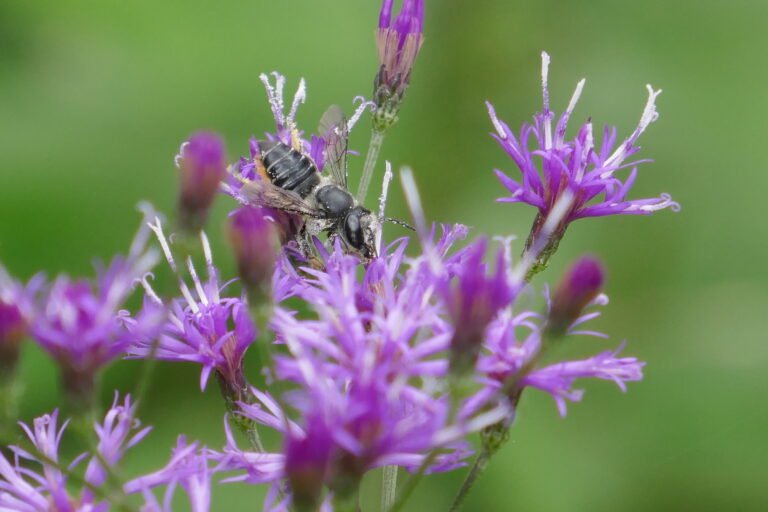
Behavior
Leafcutter bees are solitary bees and do not live in communal hives. The females nest in the ground, or in suitable vegetation.
Leafcutter bees collect pollen and nectar from many different species of flowers. If the flower is large enough, say a sunflower, the bee will rub her abdomen back and forth across the flower face to collect pollen in her basket of hairs.
The bees will be most actively searching for pollen and nectar on warm sunny days. It’s been my experience that they visit flowers early in the day before the nectar is removed by other pollinators or the flower begins to wilt. They prefer fresh flowers.
The males and females come together to mate, and other than that they rarely interact.
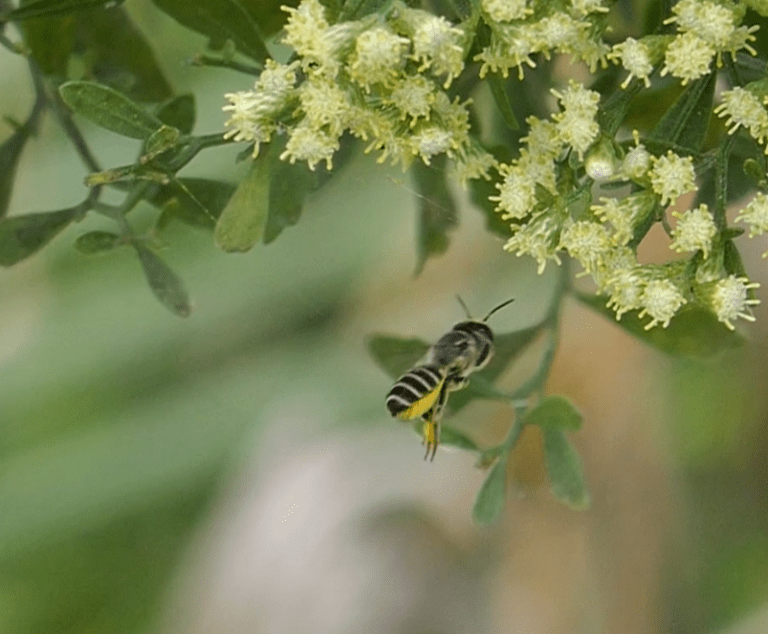
Habitat
Leafcutter bees reside in existing natural areas, restored natural areas, farms, agricultural sites, and suburban neighborhoods.
They reside anywhere there is enough natural food for them to thrive and raise their young.
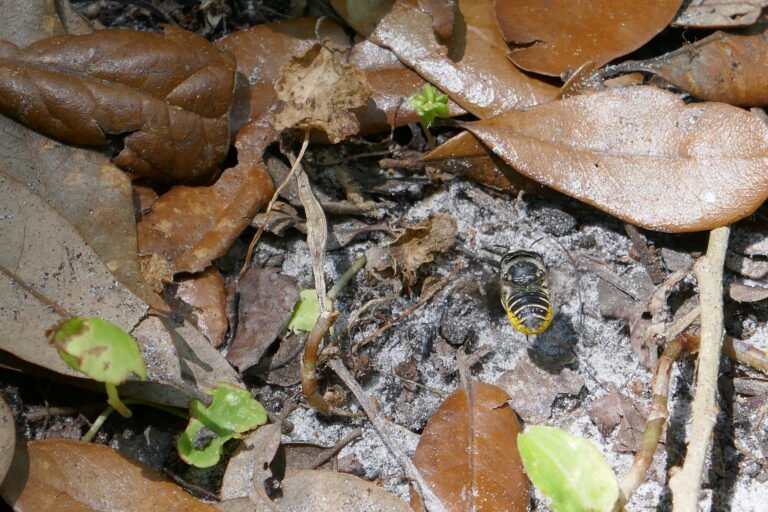
Range
Leafcutter bees are found throughout the world and are common in North America. In Florida there are approximately 63 different species (plus five subspecies) within seven genera of leafcutter bees: Ashmeadiella, Heriades, Hoplitis, Coelioxys, Lithurgus, Megachile, and Osmia. [2]
According to the University of Florida, our 63 different species are all in the Megachilidae family along with Osmia (blue mason bees) and Coelioxys (cuckoo bee). Most are about the size of a honeybee. The Megachile in my photos is most likely a Megachile brevis because it’s the only leafcutter bee I’ve found documented in Polk County.
Food
Leafcutter bees eat nectar and pollen from a wide variety of trees, shrubs, vines and wildflowers.
My experience is that their favorite flowers are in the aster family.
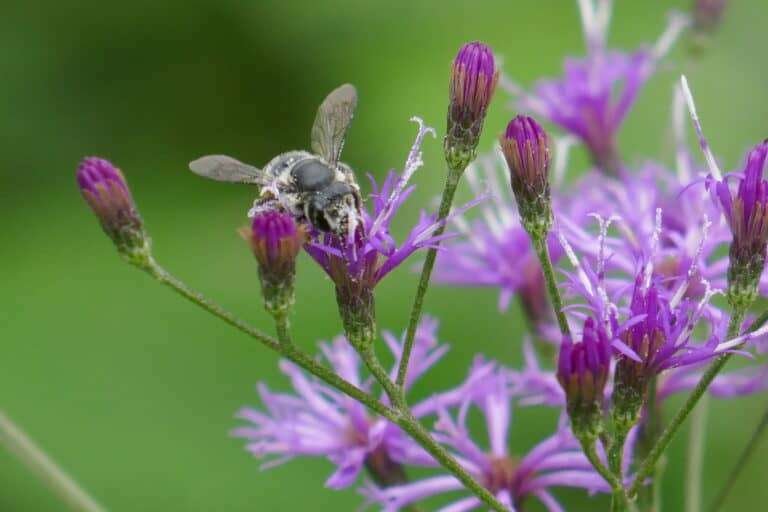
Nesting & Young
They may nest in the ground, in hollow vegetation, soft wood, or unused insect burrows where she creates chambers for her brood to live in. Females create up to 20 individual cells in each chamber.
They will use beehouses if the tube dimensions are 3/16″ (5mm) to 1/4″ (6mm) of an inch in diameter.
The mother Megachile bee brings pollen to the nest and some nectar in her crop. She kneads the mixture into a bee loaf, adding some of her saliva, which may contain antibacterial and fungicidal substances. It takes many loads to build up a bee loaf large enough to feed one grub from egg to mature size. She diligently visits numerous flowers on her quest to gather the necessary pollen and nectar. When there is enough food, she lays an egg on top. Then she seals that small chamber with chewed up leaves. If you notice nearly perfect round holes in the leaves of your rose bushes, do not begrudge them that little material that they need to raise their families. She repeats this process of making bee loaves, laying eggs and building partitions until the entire nest hole is full. Then, she builds a final, thicker wall. [3]
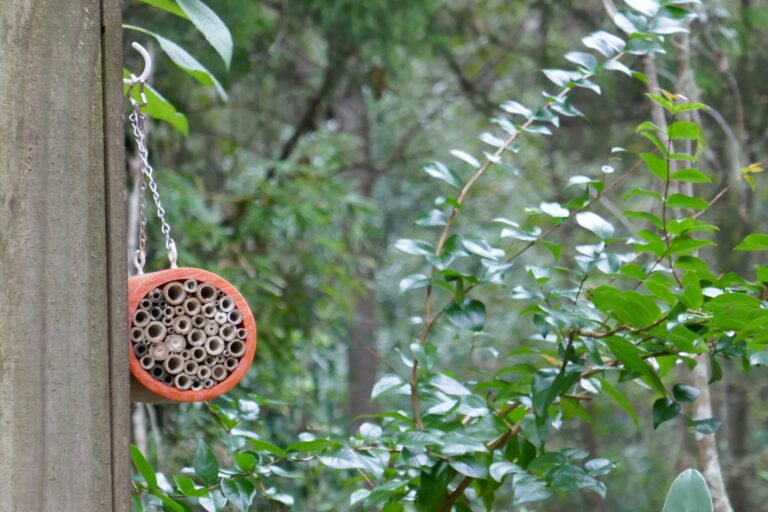
Conservation
Leafcutter bees, along with most of our native bees, are on the decline but you can help.
Our native bees, and pollinators, are being ravaged by herbicide and pesticide use with the addition of habitat loss. These adorable bees are such a treasure to our native habitat it would be a shame for them to become extinct.
You can help by providing natural areas in your yard or providing beehouses for them to nest in. They will use hollow plant stems, soft wood, rotting tree stumps, and ground cavities leftover by other insects such as beetles. Something as simple as a pile of soft wooden logs can provide an area for them to nest in. If you do make a wood pile it helps to add a roof which can be made of all sorts of things like roof tiles, wooden slats, pieces of tin or metal. Providing a roof gives them a more comfortable habitat in which to live and work when the weather is bad.
It is very easy to attract native solitary bees, such as leaf cutter bees, to your garden. First, and foremost, is to avoid the use of pesticides. Next, provide them with as many flowering plants as possible as well as deciduous shrubs and trees to use for their leaf cuts in nest building.
The easiest way to provide natural nesting areas is to leave some wild places in your green space where branches and the stalks of plants can be used by the bees for raising their young. Leave areas with spots of bare earth where they can make ground tunnels.
Beehouses can be made any shape that you can imagine, but must have tubular cells for the female bees to use. Paper straws, hollow plant stems, wood with holes drilled into it, and many other items can be used to fill the space to create a bee motel. Some literature says not to use bamboo because it can retain moisture, but I have used it quite a bit and it has never seemed to cause a problem. Keep the length of the tubes from four to eight inches. I have found it best to hot glue them together because a hungry raccoon can disassemble a bee house, made with loose straws, in a matter of minutes. Bee larva provide a nutritious meal for wildlife so make sure the house is secure and put together as strongly as possible. It’s also a good idea to make an overhanging roof to provide protection from pouring rain.
